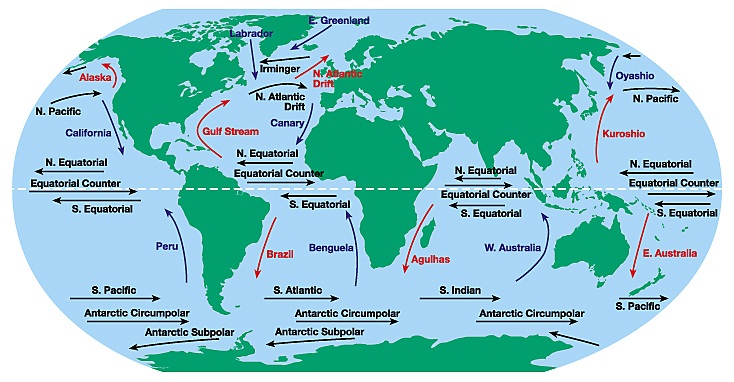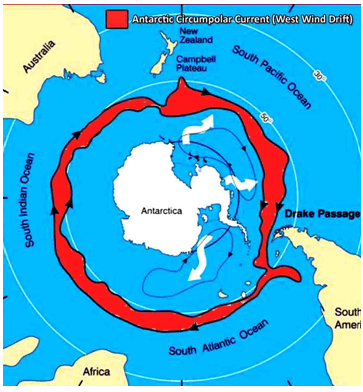Description

Disclaimer: Copyright infringement not intended.
Context
- The seafloor, reaching depths of 4,000 meters, was mapped in unprecedented three-dimensional detail, revealing a spectacular chain of eight long-dormant volcanoes, with peaks soaring up to 1,500 meters high.
About Antarctic Circumpolar Current

- It is an ocean current that flows from west to east around Antarctica.
- The current is circumpolar due to the lack of any landmass connecting with Antarctica and thus keeps warm ocean waters away from Antarctica.
- The Antarctic Convergence is associated with this current.
- It is the region where the cold Antarctic waters meet the water of the Sub-Antarctic, creating a zone of upwelling (a zone of very high marine productivity).
ATLANTIC OCEAN: NORTHERN HEMISPHERE
- The South Equatorial Current bifurcates into two branches near the Cape De Sao Roque in Brazil and its northern branch joins the North Equatorial Current.
- A part of this combined current enters the Caribbean Sea and the Gulf of Mexico, while the remaining current passes along the eastern side of the West Indies as the Antilles Current.
- The part of the current which enters the Gulf of Mexico comes out from the Florida Strait and joins the Antilles Current.
- This combined current moves along the south-eastern coast of the U.S.A. and is known as the Florida Current up to Cape Hatteras.
- Beyond Cape Hatteras, it is known as the Gulf Stream.
- The Gulf Stream starts when it exits the Florida Strait and follows North America northward to Newfoundland.
- A cold current from the Arctic Ocean called Labrador Current, which flows along the eastern coast of Canada, meets the warm Gulf Stream near the northeast corner of the U.S.A.
- The confluence of these two currents, one cold and the other warm, produce fog around the region and makes it the most important fishing ground in the world.
- The Gulf Stream then deflected eastward under the combined influence of the westerlies and the rotation of the earth.
- It then crosses the Atlantic Ocean as the warm North Atlantic Drift.
- In this journey, another cold current from the Arctic called the East Greenland Current joins with the North Atlantic Drift.
- The North Atlantic Drift bifurcates into two branches on reaching the eastern part of the ocean.
- The northern branch continues as North Atlantic Drift; reaches the British Isles from where it flows along the coast of Norway as the warm Norwegian Current and enters the Arctic Ocean.
- The southern branch flows between Spain and Azores Island as the cold Canaries Current.
- The Canaries Current finally joins the North Equatorial Current and completes the circuit.

ATLANTIC OCEAN: SOUTHERN HEMISPHERE
- The South Equatorial Current turns south and flows along the eastern coast of South America as Brazil Current.
- At about 350 south latitude, due to the influence of westerlies and the rotation of the earth, the current moves eastward.
- A cold current called the Falkland Current which flows along the south-eastern coast of South America from south to north joins with the current at this time.
- The Brazil Current moves eastward and crosses the Atlantic Ocean as South Atlantic Current.
- A part of the west wind drift or the Antarctic Circumpolar Current merges with the South Atlantic Current while crossing the Atlantic.
- Near the Cape of Good Hope, the South Atlantic Current is diverted northward as the Cold Benguela Current.
- Benguela Current finally joins with the South Equatorial Current and completes the circuit.
|
PRACTICE QUESTION
Discuss the role of the Antarctic Circumpolar Current in climate regulation. Explain how it influences global ocean circulation patterns and climate systems.
|











